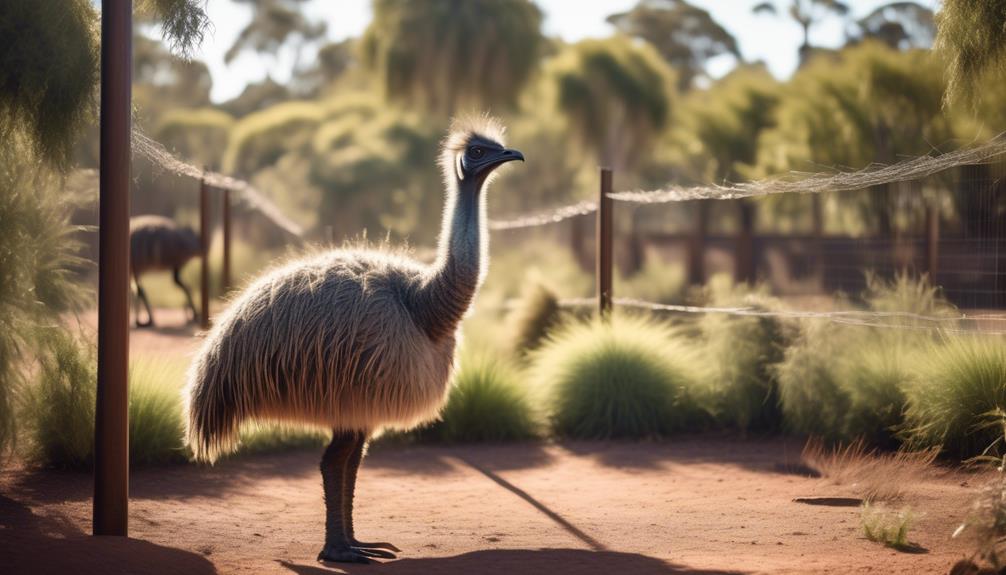
Have you ever wondered how to create a safe and secure environment for emus?
There is a theory that suggests emu-friendly fencing and enclosures can significantly contribute to the well-being and safety of these unique birds. But is it really true?
In this guide, we will explore the ins and outs of emu-friendly fencing and enclosures, providing you with valuable insights and practical tips to ensure the comfort and security of these magnificent creatures.
So, whether you are a seasoned emu enthusiast or just starting your journey, get ready to discover the secrets of creating an emu-friendly environment that will leave you amazed.
Key Takeaways
- Emus are highly social birds that thrive in groups, so it is important to consider their social behavior when designing their enclosure.
- Chain link fences are a popular choice for emu fencing due to their strength and visibility, while high-tensile electric fencing can also be effective with proper installation and maintenance.
- The ideal fence height should be at least 6 feet to balance containment and freedom for the emus, preventing most of them from escaping.
- Secure fence posts and proper installation techniques are crucial for the stability and longevity of the emu enclosure.
Understanding Emu Behavior
To ensure the safety and well-being of emus in captivity, it's essential to have a solid understanding of their behavior. Emus are highly social birds and thrive in groups, so providing them with opportunities for socialization is crucial. In the wild, emus form tight-knit family units and engage in various social behaviors such as vocalizing, grooming, and even dancing. By observing and imitating these behaviors, you can create a more enriching environment for your captive emus.
When it comes to emu breeding habits, it's important to note that these birds have a unique reproductive system. Female emus are the ones who initiate courtship, and once a pair has formed, they'll engage in a complex dance ritual. This dance involves raising their wings, puffing up their feathers, and making low rumbling sounds. After successful mating, the female will lay a clutch of eggs and the male takes on the responsibility of incubating them.
Understanding emu socialization and breeding habits allows you to provide the necessary conditions for their overall well-being in captivity. By promoting social interactions and creating a suitable breeding environment, you can ensure that your emus thrive and lead fulfilling lives.
Choosing the Right Fencing Material
Understanding emu behavior is essential for creating a suitable environment, and one important aspect to consider is choosing the right fencing material. When it comes to emu-friendly fencing, durability and cost considerations play a crucial role.
To ensure the safety and security of your emus, it's important to choose a fencing material that can withstand their strength and size. Emus are known to be powerful birds, capable of jumping high and exerting force on fences. Therefore, selecting a durable material is essential to prevent them from escaping or damaging the enclosure.
One popular choice for emu fencing is chain link. It's a strong and sturdy material that can withstand the pressure exerted by emus. Additionally, chain link fences offer good visibility, allowing you to keep an eye on your emus at all times.
Another option is high-tensile electric fencing. This type of fencing uses wires with high tensile strength, making it difficult for emus to break through. Electric fencing can be an effective solution, but it requires proper installation and maintenance to ensure optimal performance.
When considering fencing material, it's also important to take cost into account. While some materials may be more expensive upfront, they may offer greater durability and require less maintenance in the long run. It's important to strike a balance between cost and quality when choosing the right fencing material for your emus.
Determining the Ideal Fence Height
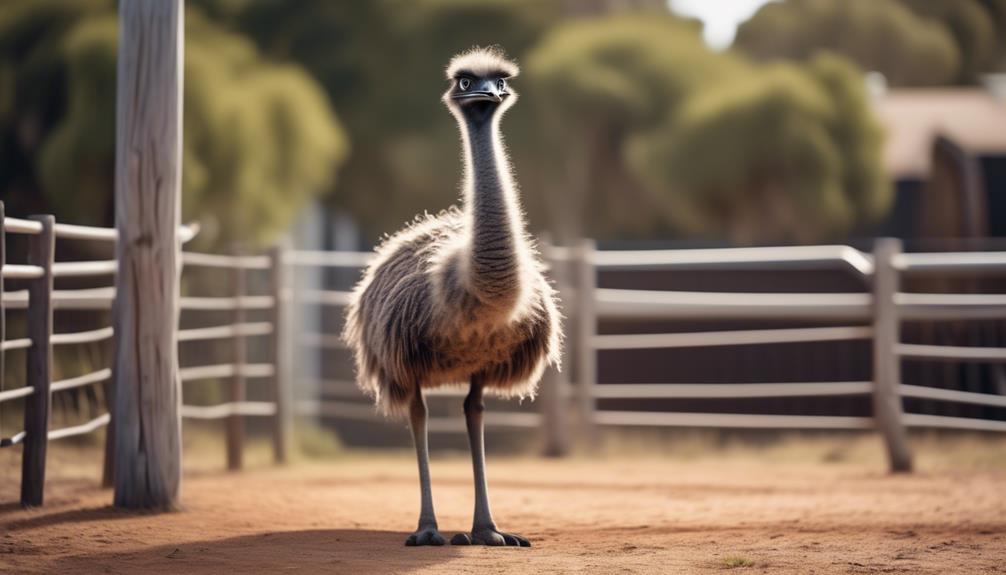
When determining the ideal fence height for your emus, consider their size and jumping capabilities. Emus are large birds that can reach up to 6 feet in height. They're also known for their impressive jumping abilities, which can enable them to scale fences if not properly secured. To ensure the safety and containment of your emus, it's important to choose a fence height that they can't easily clear.
Here are some factors to consider:
- Emu jumping abilities:
- Emus are capable of jumping up to 6 feet in height.
- Their powerful legs allow them to propel themselves over obstacles.
- Impact of fence height on emu behavior:
- A fence that's too low may encourage emus to jump over and escape.
- A fence that's too high may discourage emus from attempting to jump, but it can also make them feel trapped and stressed.
To strike a balance, it's recommended to install a fence that's at least 6 feet high. This height will prevent most emus from clearing the fence while still providing them with a sense of security and freedom.
Remember to regularly inspect and maintain your fence to ensure its integrity and effectiveness in keeping your emus safely contained.
Installing Secure Fence Posts
Secure fence posts are essential for ensuring the stability and longevity of your emu enclosure. When installing fence posts, it's important to follow a few key steps to ensure their proper installation and security.
Firstly, you'll need to gather the necessary materials, including fence brackets and the appropriate tools. Fence brackets play a crucial role in securing fence panels to the posts, so make sure you have enough brackets for the length of your enclosure.
Next, mark the positions where the fence posts will be installed. Use a measuring tape to ensure accurate spacing between each post. Dig holes for the posts, making sure they're deep enough to provide sufficient stability.
Once the holes are dug, place the fence posts in the holes and secure them with concrete. This will provide a strong foundation for the posts and prevent them from shifting or leaning over time.
After the concrete has set, attach the fence brackets to the posts using screws or nails. Make sure the brackets are securely fastened to provide maximum support for the fence panels.
Adding Electric Wire for Extra Security
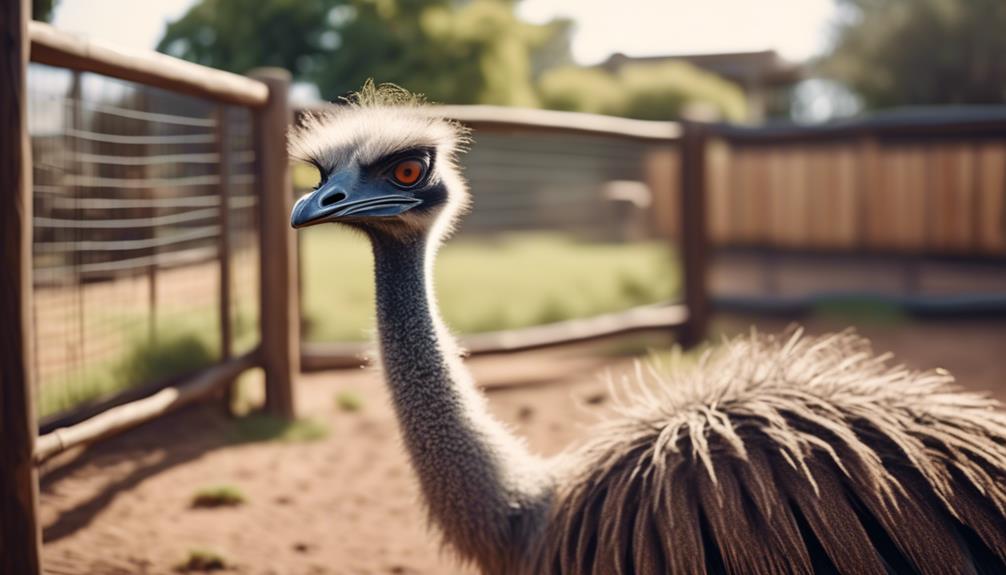
To further enhance the security of your emu enclosure, consider adding electric wire as an additional measure of protection. Electric wire acts as a deterrent, providing a safe and effective way to keep your emus inside while keeping potential threats out.
Here are some electric wire installation techniques to ensure maximum security:
- Choose the right wire: Opt for a high-tensile wire specifically designed for electric fencing. This wire is durable and can withstand the pressure exerted by emus.
- Proper grounding: Grounding is crucial to ensure the electric fence functions effectively. Connect the grounding system to a metal rod or grounding plate buried at least three feet deep into the ground. This will complete the electric circuit and provide a safe shock to any intruders.
When installing electric wire, keep the following considerations in mind:
- Wire height: Place the bottom wire at a height of around 12 to 18 inches from the ground to prevent emus from ducking under it. Space additional wires at intervals of 12 to 18 inches above the bottom wire.
- Voltage: Set the electric fence to a voltage that's safe for emus but effective in deterring predators. Consult with a professional to determine the appropriate voltage level.
Designing a Spacious Emu Enclosure
Consider incorporating spacious design elements into your emu enclosure for optimal comfort and mobility. A well-designed emu enclosure not only provides a safe and secure environment for your birds but also allows them to move freely and exhibit natural behaviors.
When it comes to maximizing space in your emu enclosure, there are a few key design considerations to keep in mind.
Firstly, ensure that the enclosure is large enough to accommodate the number of emus you plan to house. Emus are large birds and require ample space to roam and stretch their wings. A general rule of thumb is to provide at least 250 square feet of space per adult emu.
Secondly, consider the layout of the enclosure. Providing a variety of terrain such as grassy areas, sandy patches, and rocky surfaces can create a stimulating environment for your emus. It also allows them to engage in natural behaviors like foraging and dust bathing.
Additionally, incorporating shelters and shade structures within the enclosure is essential. Emus need protection from the elements, especially during extreme weather conditions. Providing shaded areas also helps to prevent overheating and sunburn.
Lastly, consider the fencing design. Ensure that the fence is sturdy and secure to prevent escapes and keep predators out. The fence height should be at least six feet to prevent emus from jumping over.
Providing Adequate Shelter and Shade
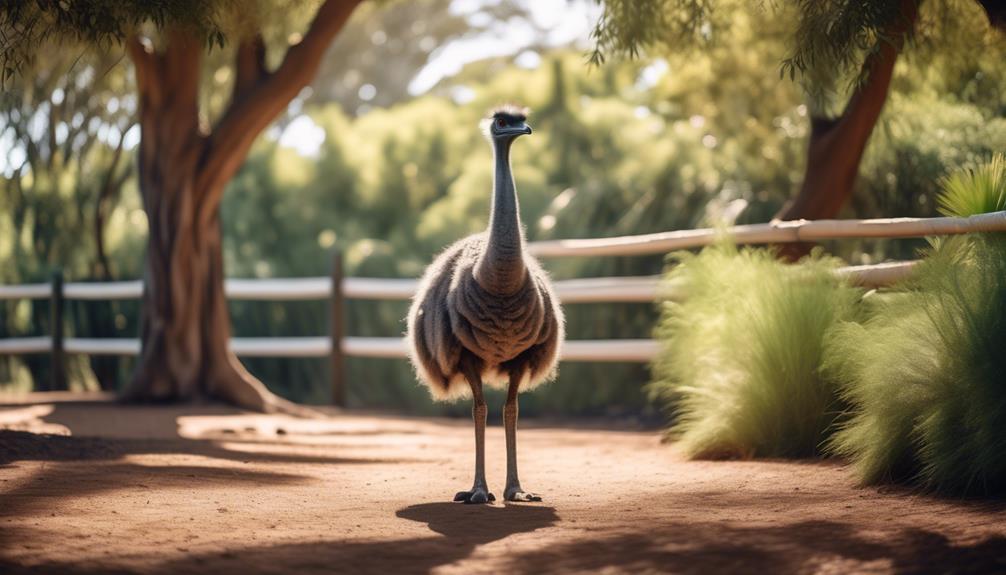
Ensure that your emu enclosure provides adequate shelter and shade to protect your birds from the elements. Emus need shelter to escape from extreme weather conditions. Here are some emu shelter types and shade options for their enclosures:
- Shelter Types:
- Sheds or Barns: Construct a sturdy shed or barn within the enclosure to provide a safe and dry space for your emus. Make sure it's well-ventilated and spacious enough to accommodate all of your birds comfortably.
- Natural Shelters: Arrange large rocks or trees strategically in the enclosure to create natural shelters for your emus. These will provide shade and protection from the sun, rain, and wind.
- Shade Options:
- Shade Cloth or Netting: Install shade cloth or netting over a designated area in the enclosure to create a shaded spot for your emus. This will help protect them from direct sunlight and reduce the risk of heat stress.
- Planting Trees: Consider planting trees that provide dense foliage to create natural shade in the enclosure. This won't only offer protection from the sun but also add a natural aesthetic to the environment.
Creating a Suitable Feeding Area
Create an emu-friendly feeding area that meets their dietary needs and promotes optimal health.
Emus have specific feeding requirements that must be met to keep them healthy and happy. To start, provide a designated feeding area with enough space for all your emus to comfortably eat. This will prevent any competition or aggression during feeding time.
Emus are grazers, so ensure the area has plenty of grass and vegetation for them to nibble on throughout the day. Supplement their diet with a balanced emu feed that contains the necessary nutrients they need.
It's important to follow a proper feeding schedule to avoid overfeeding or underfeeding. Emus should be fed twice a day, in the morning and evening, to maintain a consistent routine.
Make sure to provide fresh water at all times and regularly clean their feeding area to prevent any contamination.
Regular Maintenance and Inspections
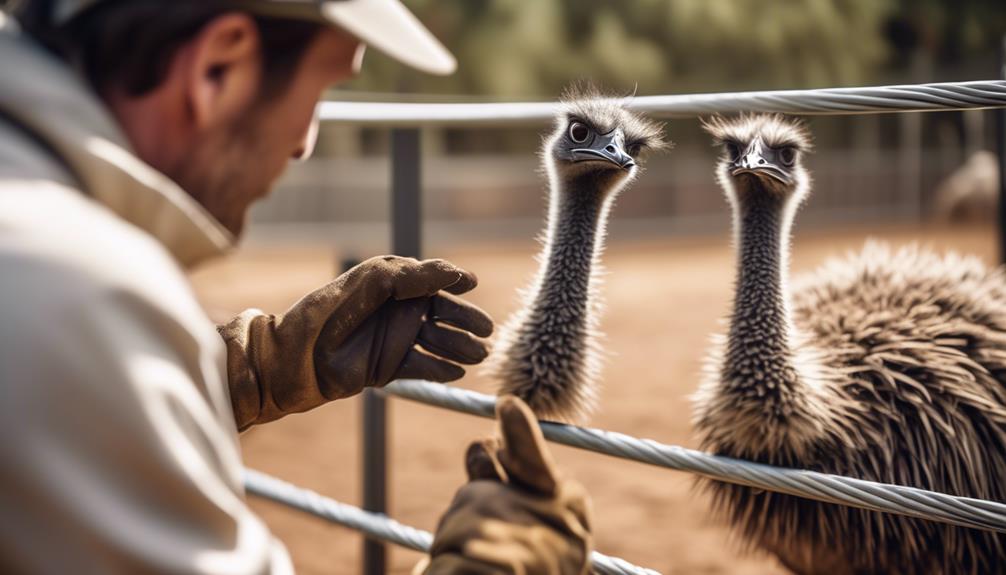
Regular maintenance and inspections are essential to ensuring the longevity and safety of your emu enclosure. By regularly inspecting and maintaining your enclosure, you can catch any issues or wear and tear before they become major problems. Here are some important steps to take in order to keep your emu enclosure in top condition:
- Conduct regular inspections:
- Inspect the fencing for any signs of damage, such as loose wires or broken posts. Repair or replace any damaged areas promptly.
- Check the gate hinges and latches to ensure they're secure and functioning properly. Emus are curious and can be quite strong, so it's important to have sturdy and reliable gates.
- Examine the netting or mesh for any holes or tears that could allow predators to enter. Patch up any openings immediately to keep your emus safe.
- Ensure durability:
- Trim any overhanging branches or vegetation near the enclosure. This will prevent emus from using them to jump over the fence and also reduce the risk of damage caused by falling branches.
- Regularly clean and disinfect the enclosure to prevent the buildup of bacteria or parasites that could harm your emus.
Frequently Asked Questions
How Do Emus Typically React to Loud Noises or Sudden Movements?
Emus typically startle easily by loud noises or sudden movements. Their reaction can range from freezing in place to fleeing. It's important to provide them with a calm and quiet environment to ensure their well-being.
Are There Any Specific Plants or Trees That Should Be Avoided When Designing an Emu Enclosure?
When designing an emu enclosure, it's important to consider the plants and trees. Some species can be harmful to emus, causing digestive issues or even toxicity. Ensuring proper vegetation promotes the overall welfare of these majestic birds.
Can Emus Jump Over Fences, or Are They More Likely to Try to Dig Under Them?
Emus can jump over fences, but they are more likely to try to dig under them. They have impressive jumping abilities, so make sure your fencing is secure. They may also be territorial towards other animals.
What Are Some Common Signs of Stress or Discomfort in Emus?
You might think emus are as cool as cucumbers, but they can actually get stressed too. Signs of stress in emus include feather plucking, pacing, and aggressive behavior. Creating a stress-free environment is key.
What Steps Can Be Taken to Prevent Emus From Attempting to Escape Their Enclosure?
To prevent emus from escaping their enclosure, ensure the fence is high enough and well-maintained. Secure gates and entrances are essential. Incorporate natural and visual barriers to deter escape attempts.
Conclusion
In conclusion, with the right fencing and enclosure setup, you can create a safe and comfortable environment for your emus.
Picture a sturdy fence made of durable material, standing tall and secure. Electric wires add an extra layer of protection, keeping these curious creatures contained.
Inside the enclosure, imagine spacious grounds with plenty of shade and shelter, allowing the emus to roam freely. Don't forget a well-designed feeding area and regular maintenance to ensure their well-being.
Follow these guidelines and watch your emus thrive.


